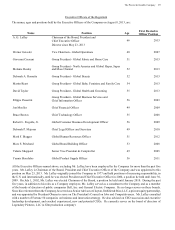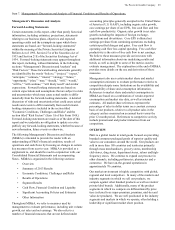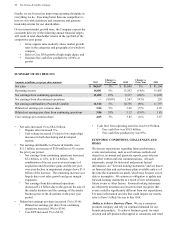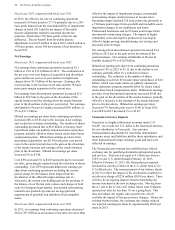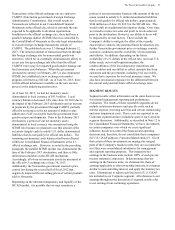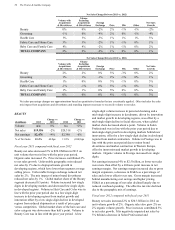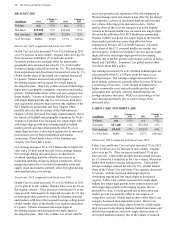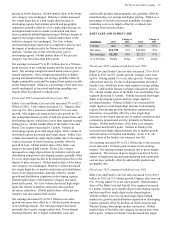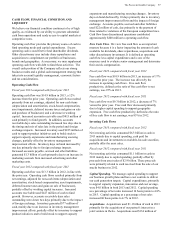Proctor and Gamble 2013 Annual Report Download - page 30
Download and view the complete annual report
Please find page 30 of the 2013 Proctor and Gamble annual report below. You can navigate through the pages in the report by either clicking on the pages listed below, or by using the keyword search tool below to find specific information within the annual report.
28 The Procter & Gamble Company
ability to leverage our organization and systems
infrastructures to support business growth. Accordingly, we
generally experience more scale-related impacts for these
costs.
In February and November 2012, the Company made
announcements related to a productivity and cost savings
plan to reduce costs in the areas of supply chain, research
and development, marketing and overhead expenses. The
plan is designed to accelerate cost reductions by
streamlining management decision making, manufacturing
and other work processes in order to help fund the
Company's growth strategy. The Company expects to incur
in excess of $3.5 billion in before-tax restructuring costs
over a five-year period (fiscal 2012 through fiscal 2016) as
part of this plan. Overall, the costs are expected to deliver in
excess of $2.0 billion in before-tax annual savings.
Net Sales
Fiscal year 2013 compared with fiscal year 2012
Net sales increased 1% to $84.2 billion in 2013 on a 2%
increase in unit volume. Volume in Baby Care and Family
Care grew mid-single digits. Volume in Fabric Care and
Home Care and in Health Care grew low single digits.
Beauty volume was in line with the prior year. Grooming
volume decreased low single digits. Volume grew low
single digits in both developed and developing regions. The
impact of overall global market growth was partially offset
by market share declines in certain categories. Price
increases added 1% to net sales, driven by price increases
across all business segments, primarily executed in prior
periods to offset cost increases and devaluing developing
market currencies. Foreign exchange reduced net sales by
2%. Organic sales growth was 3% driven by both volume
and price increases.
Fiscal year 2012 compared with fiscal year 2011
Net sales increased 3% to $83.7 billion in 2012 on unit
volume that was consistent with the prior year period.
Difficult macroeconomic conditions caused a slowdown in
market growth in fiscal 2012, particularly in developed
markets. In addition, we initiated a number of price
increases across each reportable segment in fiscal 2012, in
large part to recover the rising cost of commodities and
currency devaluations. These factors negatively impacted
volume growth in 2012, but the price increases led to higher
overall sales. Volume grew low single digits in Beauty,
Grooming, Health Care, and Baby Care and Family Care.
Fabric Care and Home Care volume decreased low single
digits. Volume grew mid-single digits in developing regions
and was down low single digits in developed regions. The
impact of overall global market growth was partially offset
by market share declines in certain categories. Price
increases added 4% to net sales, driven by price increases
across all business segments and regions, primarily to help
offset commodity costs and devaluing currencies in certain
developing markets. Mix reduced net sales by 1% due to
unfavorable geographic mix across the Beauty, Grooming,
Health Care and Fabric Care and Home Care reportable
segments and unfavorable product mix. Foreign exchange
was neutral to net sales. Organic sales growth was 3%
driven by price increases.
Operating Costs
Comparisons as a percentage of net sales; Years ended June 30 2013
Basis Point
Change 2012
Basis Point
Change 2011
Gross margin 49.6% 30 49.3% (160) 50.9%
Selling, general and administrative expense 32.0% 50 31.5% (30) 31.8%
Goodwill and indefinite-lived intangible asset and impairment
charges 0.4% (150) 1.9% 190 —%
Operating margin 17.2% 130 15.9% (320) 19.1%
Earnings from continuing operations before income taxes 17.6% 230 15.3% (320) 18.5%
Net earnings from continuing operations 13.5% 240 11.1% (330) 14.4%
Net earnings attributable to Procter & Gamble 13.4% 50 12.9% (170) 14.6%
Fiscal year 2013 compared with fiscal year 2012
Gross margin expanded 30 basis points in 2013 to 49.6% of
net sales, driven by higher pricing and manufacturing cost
savings, partially offset by negative mix and higher
commodity costs. Gross margin was positively impacted by
70 basis points from higher pricing and approximately 160
basis points from manufacturing cost savings. Gross margin
was negatively impacted by 160 basis points from negative
geographic and product mix behind disproportionate growth
in developing regions and mid-tier products, both of which
have lower gross margins than the Company average. Gross
margin was also reduced by capacity investments and to a
lesser extent by foreign exchange impacts and higher
commodity costs.
Total SG&A increased 2% to $27.0 billion in 2013, driven
by a charge for the balance sheet impact from the
devaluation of the official foreign exchange rate in
Venezuela and an increase in marketing spending, partially



